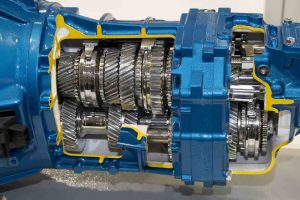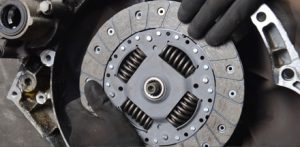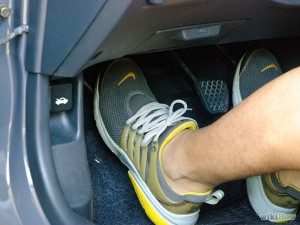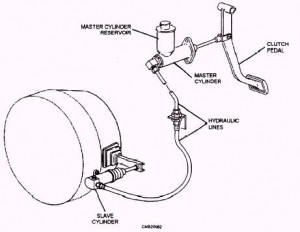Manual transmissions are interesting things in that they are probably one of the last things about moden cars that haven’t been turned into electronic things.
They are still essentially mechanical things – gears and synchros, rods and forks. The works turned by mechanical force, a physical clutch and flywheel, the interaction controlled by another non-electronic thing (that’s you).
Essentially the same now as they were fifty years ago, when cars were still largely mechanical things.
They are much simpler things for this reason than modern automatic transmissions – which used to be essentially hydraulic things but which have become as electronicized as the engines they are bolted to.
This has made them very complex things. Which has also made them very expensive things.
It has also made them more failure prone things, simply because there are so many potential failure points.
Which makes a manual transmission that much more appealing as a way to hedge your bets against future failure – and repair costs – as well as a way to decrease the right-now cost of the car, itself, since it usually costs more to buy a new car with its optionally available automatic as opposed to the standard manual.
Assuming you can find a new car that’s still available with a manual.
There are just a few – sports cars like the Mazda Miata – and a handful of economy cars like the Hyundai Accent.
It’s ironic that so few modern economy cars even offer manuals anymore given that automatics cost more to buy (that bit about their greater complexity) which makes the economy car a less economical car – to buy – and also a less economical car to repair, if the automatic fails and needs to be replaced.
Many modern automatics (especially continuously variable or CVT automatics) being not repairable when they fail. You buy a new one. But – as OJ used to say – look out! A modern electronic-hydraulic transmission can cost so much to replace when it fails that it may not be worth replacing it when it fails . . . if it fails after the car, itself, has depreciated to the point that it is only worth what it would cost to replace the transmission that just failed.
This point of diminishing returns arrives much sooner than many people realize. Would you spend $4k to put a new automatic in your ten-year-old car that’s worth maybe $8k? Better change that fluid per the factory recommended intervals – and maybe sooner. Even better, read up on which types (and makes) of automatic transmissions have a not-so-great track record for long-term reliability.
Hint: The ones that fall into that box have three letter names – like CVT and DSG.
Manuals rarely fail, provided they aren’t abused. This includes once-in-awhile changes of the lube inside the box that keeps the gears spinning freely and keeps them – and other related parts – from overheating due to increased friction and so on.
Barring that, a manual ought to last the life of the vehicle.
Even, possibly, the clutch – the part that’s designed to wear out – and it’s not even (technically speaking) part of the transmission, itself.
The clutch is the friction surface that interfaces he transmission with the spinning flywheel, clamping onto it much in the way that your brake pads clamp onto the spinning brake disc, to stop your car. The difference being your car moves (rather than stops) when the clutch is clamped to the flywheel (assuming you’re in gear, of course).
What’s the same is that both the clutch and brake pads wear from the friction of all that clamping down and – eventually – both require replacing. The good news is that – unlike the cost of replacing an automatic transmission – it doesn’t cost more than the car is worth to replace the clutch when – if – it becomes necessary.
Even better news is that you can greatly increase the time in between replacing by decreasing the friction.
Avoid engaging the clutch abruptly. Ease it in – and out. Especially when it’s cold and the drivetrain hasn’t warmed up yet.
When you first start the engine in the morning, let the clutch out gently – and let the engine idle for 30 seconds or so. Modern engines don’t need “warm up” times but by doing this, you will let the engine rotate the transmission’s internals and get them nicely lubed up, before applying any load to them.
Thereby decreasing friction when you begin shifting.
Your gears, rods, forks and synchros – and pilot bearing – will thank you, by not costing you.
Don’t keep the clutch depressed when the car isn’t moving. Put the transmission in neutral and let the clutch out until the light turns green.
Again, your pilot bearing will thank you.
Try not to spin the engine too fast – and take too long to ease in the clutch. The sweet spot is a smooth syncopation, the feel of a car with an automatic, if you get it just right.
Most of all, try not to stop – when you can avoid it.
Most of the wear on the clutch occurs when you’re getting going from a dead stop. The clutch is the link between the dead weight of your vehicle and the spinning flywheel. If you’re still moving, even a little, there will be much less friction-force applied to the clutch when you ease it back in.
Inertia is your friend.
You might be surprised how easy it is to keep rolling, just a little, if you pay attention to the ebb and flow of traffic and time yourself in relation to it. If you can avoid coming to a full stop even a fourth of the time, you’ve likely saved a corollary amount of clutch material over time.
Drive it right and you can get 150,000-plus miles out of a clutch. Treat it right and the transmission, itself, ought to last another 150,000.
Provided you make sure it never runs low. . .
One of the weak spots of manuals is they don’t have dip sticks. You may have to unscrew a sight hole/fill hole in the side of the transmission’s case to establish the fill level. It’s a small hassle but good policy to do this at least every 30,000 miles or so – and to change out the lube (fluid) every 100,000 miles or so – irrespective of any claims about “lifetime” lube.
One last thing to check – and change, periodically if you want a Methuselean manual.
Modern manuals – which encompasses most installed since the ’80s – have hydraulically assisted clutches, which makes the clutch easier to work. Many also have automatic self-adjusting clutches, further reducing wear as well as maintenance.
The weak point – if you let it be – is the hydraulic circuit that serves these purposes.
It consists of a slave cylinder – which is very much like a brake master cylinder – and works on the same principle. When you depress the clutch, you are actually displacing fluid, which cannot be compressed – multiplying the force applied by your depressing of the clutch.
But just like a brake master cylinder/circuit, the brake fluid inside the slave cylinder goes bad over time. And so will the slave cylinder, if you don’t regularly change out that fluid. Many people are unaware of this need-to-do item or forget to do it and they end up paying for it.
If you want to avoid that, don’t fail to do it (or have it done) at least once every five years.
If you do that – and the rest – you may not have to change anything for a very long time, indeed.
. . .
Got a question about cars, bikes, or Sickness Psychosis? Click on the “ask Eric” link and send ’em in! Or email me at EPeters952@yahoo.com if the @!** “ask Eric” button doesn’t work!
If you like what you’ve found here please consider supporting EPautos.
We depend on you to keep the wheels turning!
Our donate button is here.
If you prefer not to use PayPal, our mailing address is:
EPautos
721 Hummingbird Lane SE
Copper Hill, VA 24079
PS: Get an EPautos magnet or sticker or coaster in return for a $20 or more one-time donation or a $10 or more monthly recurring donation. (Please be sure to tell us you want a magnet or sticker or coaster – and also, provide an address, so we know where to mail the thing!)
My eBook about car buying (new and used) is also available for your favorite price – free! Click here. If that fails, email me at EPeters952@yahoo.com and I will send you a copy directly!













This article describes my driving habits.
In 45 years of driving I’ve never had a clutch wear out, nor have I ever changed transmission fluid.
Just go easy on your vehicle, feed it well, give it a wee blast now and then to clear the cobwebs and it will last you a long time.
BTW, I only had an automatic for 5 years when I was in NC. In the UK ,most are all manual.
anon 1
are manual transmissions cheap?
I had a 1992 Mk 2 VW Golf diesel na 1.6 lt. 5 speed. a used 5 speed transaxle for it cost me $100 and $350 labor to install. it also got 40 mpg city 60 mpg hiway. if you want to save money get one. these go 300,000 miles easily.
a new trans installed on a new car could cost up to $10,000
anon 1
A manual trans also saves on brake wear because of engine braking, just lift of the throttle, an automatic eats brakes, no engine braking, more savings.
An automatic wears out quicker partly because they shift far too much, the new ones have up to 10 gears. In my manual trans cars I will cruise around the city, (apart from stopping at traffic lights), in one gear only, 3rd gear, for responsiveness, instant response and engine braking with no shifting, if you floor an automatic it downshifts 3, or 4, or 5 gears and starts screaming, a slight delay, no instant response. on the highway over 55 mph with a 5 speed 5th is fine, less engine wear and noise and if you floor it, it doesn’t downshift a bunch of gears..
if you get an automatic get a sequential racing trans, you start off with the clutch, after that you just push the stick forward to downshift or pull it back to upshift, at full throttle no clutch needed, a great toy….. see below
https://www.youtube.com/watch?v=lBrzpayx-zw
Well you cant use the term ‘master bedroom’ anymore so you sure cant say ‘slave cylinder’ The new term is ‘historically oppressed cylinder’ Geez Eric get with it. Good stuff. Love my manny crosstrek so will stert to pay attention to the recommended fluid intervals!
‘Manual transmissions are … one of the last things about modern cars that haven’t been turned into electronic things.’ — eric
Tech lords openly declare war on us and our vehicles:
‘The smartphone wars are over, and Google and Apple won. Now they — and Amazon — are battling to control how you operate within your car.
“The ride is no longer the point,” said Jim Heffner, a vice president at Cox Automotive Mobility who specializes in autonomous and connected vehicles. “Data is the cornerstone. … Apple and Google and others want to be at the epicenter of that.”
‘Now, the tech companies are looking to eliminate any choice of technology, building the software for the car itself.
‘Only Google and Ford will have access to the user data generated by Ford’s system, which will be stored in Google Cloud.
‘Heffner suggested Amazon might be willing to move to a model where it explicitly offers rides in exchange for transactions and data.
“In the future, when transportation is just a mode of moving from point A to point B, Amazon will want its marketplace to be available for consumers there as well.”
https://www.politico.com/news/magazine/2021/12/27/self-driving-car-big-tech-monopoly-525867
Such a deal: as inscrutable algorithms shuttle you like the meat sack you are from point A to point B, you get bombarded with sales pitches, as Alexa records every word you say and GPS records every stop you make.
Nineteenth century slaves were only physically restrained; 21st century serfs will be cognitively ruled.
Eric — extra literary points for coining ‘Methuselean’ as an adjective.
Double extra points for employing the Oldspeak ‘slave cylinder,’ a banned term which actually caused the textbook Digital Design, 6th Edition to be withdrawn from the market last year by its publisher.
When we are all enslaved, it is forbidden to speak of slavery.
anon 1
the ancient serfs paid less taxes and had more freedom then the serfs today, but they were so pissed off at their rulers, when Rome was invaded by the Huns they invited them in, where are the Huns when we need them?
Love Manual, Ill never own another automatic ever again
Drove through 3 of the 5 boroughs on monday with my new girl, no issues at all, and people always cite city driving and traffic as reasons not to drive a Manual, theyre the same people who need awd for those 3 rotten months of the year when it snows, rather than simply saving $$$ and slapping on snow tires
Other than oil leaks, never had any problems with any GM automatics – Powerglides to Turbo-Hydramatics.
If everyone drove a manual the roads would be safer because you can’t space out and play follow the leader to the extent you can with an automatic. Even the mechanically ignorant manual driver quickly learns that jackrabbit start to screeching halt is not an optimal strategy for stop and go traffic. And once you realize that, suddenly you’re leaving more space, accelerating slowly and rarely touching the brakes. I’ve always entertained myself in traffic by attempting to never use the brakes. Like truckers.
There is a Japanese traffic study with 50 cars driving a short loop with no instructions except “maintain same following distance.” The “leader” drives constant 20mph. Within 2-3 laps there is stop and go traffic! All because people suck at driving smoothly.
Ignoring brake wear, what are your thoughts on long downhill grades with a manual? Coasting in neutral plus brakes (if necessary to stay at reasonable speed) or compression braking? And what about coasting in an Automatic in N? I worry that something isn’t getting lubricated in neutral (whether manual or auto) but I’ve had any problems from doing it either when I’ve done it for extended periods (e.g. 5 minutes) running on fumes trying to make it to a gas station on the other side of a mountain pass.
For sure, if there is a line of traffic at a round about, leave it second gear, idle revs keep you moving and rarely do I need to stop or drop into first. I hate stop and go, just crawling along is much less stressful.
The only automatic I own is in my F150. All the other 6 are manual.
Last year I had the clutch replaced in the ’06 Corolla, $650. That, of course, included the pressure plate, release and pilot bearings. The fwd package makes the job much more difficult, in my mind. However, it’s still better than an automagic trans.
Your comment on CVT nails it. These are generally the weakest link, by far, on new cars. The complexity of DSG is mind boggling.
Technology is great when it makes life simpler. What we’re seeing today in cars [and many computer applications] is technology for its own sake…Contrived Complexity, if you will. Just because you can, doesn’t mean you should.
I have driven many manual transmisions, more than automatics. I had an ’88 ford ranger which I drove 215,000 on the same clutch, and I sold it without ever having problem one with it. Drive it right and it lasts the vehicles lifetime.
I am so happy with the elegant and joyful to operate six speed in my 718. It turns the daily drive from a chore to a sport.
I never intended the 718 to be my daily driver but more and more I find myself choosing it instead of the SUV unless I need the space on that day.
It is a wonderfully satisfying skill to be able to stir your own gears and far from getting frustrated in bad traffic I find that working the gears is an entertaing distraction from the routine gas/brake tap dance.
Eric is right about watching the traffic dynamics to avoid stopping.
I laugh at the fools whipping around me and hauling ass to the next red light only to slam on the brakes. With a little practice I am able to traverse Beach Boulevard in Jacksonville in the morning and not have to stop more than once or twice from the intracoastal bridge all the way past downtown.
I look at it as a challenge.
Bravo.
BTW all 3 of my daughters learned to drive on a manual and all 3 took their driving test with a stick shift.
The last clutch kit I had replaced at around 150,000 ran me about $750.00. The last transmission I had replaced at around 190,000 was around $3400.00.
I almost lament at how few cars come with a manual transmission especially trucks. The eight speed automatic in my ram truck works great under heavy load, but it doesn’t make me miss the 5 speed with a third pedal any less. It feels almost blasphemous that even most HD trucks don’t even offer stick shift anymore
Hi Sicilian,
My ’02 Nissan Frontier still has its factory clutch at appx. 140,000 miles. I have the new one ready, whenever it becomes necessary. Cost me about $100 (yep, really – see here: https://www.rockauto.com/en/catalog/nissan,2002,frontier,2.4l+l4,1388033,transmission-manual,clutch+kit,1993 )
Good luck finding a working used/parts-place salvage automatic for that!
I’m thinking about doing a “manual swap” on my ’02 A6 Avant. I’m getting transmission codes and it’s been clunking pretty bad past few years. And yes, in either case of replacing the existing automatic or the manual swap, it will cost significantly more than the car is worth (even with a working tranny).
It’s probably just an impossible pipe dream but I think that, if I can get it road worthy again, it’ll be a good vehicle to have when the EVs take over. Now if I could just convince the wife of such.
Hi EM,
Physically, the swap should be doable. The problem you may encounter is that the computer may not be compatible. It may be necessary to swap the original for one from a same-year/same-type Audi that originally came with the manual…
My 2014 Mazda 3 has an automatic, and I was shocked to find that there isn’t an easy way to check the fluid (the only place is very inaccessible and bolted down), and you can’t even change the fluid if you want!
Hi Gary,
First, they came for the drain plugs… which automatic transmissions uses to all have. Which made draining the transmission fluid as easy as draining engine oil. Then they eliminated them, so as to make it a messy PITAS for the average Joe to drain the fluid/replace the filter. Now they’re getting rid of the dipstick – so the average Joe can’t even check the level – and how do you refill it, if it’s low?
Answer – by getting underneath the car and accessing the fill-hole, very awkward and a PITAS.
Yeah, from what I’ve read, you have to remove all the gas saving plastic air dam/shield that completely covers underneath the engine. Then find a bolt that holds the dipstick in. There is a drain, of sorts, but it’s my understanding that it will only allow about half of the fluid to run out. The best you can do is mix new fluid with old, and that just sucks.
> My 2014 Mazda 3 has an automatic, and I was shocked to find that there isn’t an easy way to check the fluid
I had a 2004 Oldsmobile Alero that was like that. There was a filler cap on top, under the exhaust crossover (mine was a V6) that looked like the cap you might find on a bottle, and that was it. No dipstick. If I had to guess, they figured that automatics (this one was a 4-speed of a type GM had probably been building since the ’80s) were getting nearly as bulletproof as manuals, and that the fluid and filter should last the life of the car.
I’ve always been paranoid about the life span of automatics. With even more reason to be so, given the “it works or it doesn’t” aspect of current automatics, and the requirement to replace instead of repair them. There used to be a local shop that specialized in transmission repair. They are no longer in business. Manuals seldom need repair, and automatics no longer can be.